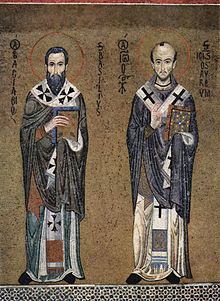This article may require cleanup to meet Wikipedia's quality standards. The specific problem is: Mish mash of proportionate and disproportionate bits of information. (July 2018) |

Divine Liturgy (‹See Tfd›Greek: Θεία Λειτουργία, translit. Theia Leitourgia) or Holy Liturgy is the usual name used in most Eastern Christian rites for the Eucharistic service.

The Greek Catholic and Orthodox Churches see the Divine Liturgy as transcending time and the world. All believers are seen as united in worship in the Kingdom of God along with the departed saints and the angels of heaven. Everything in the liturgy is seen as symbolic, but not merely so, for it makes present the unseen reality. According to Eastern tradition and belief, the liturgy's roots go back to the adaptation of Jewish liturgy by Early Christians. The first part, termed the "Liturgy of the Catechumens", includes like a synagogue service the reading of scriptures and, in some places, perhaps a sermon/homily. The second half is based on the Last Supper and the first Eucharistic celebrations by Early Christians and it is called "Liturgy of the Faithful". Eastern Christians believe that the Eucharist is the central part of the service in which they participate, as they believe the bread and wine truly become the real Body and Blood of Christ, and that by partaking of it they jointly become the Body of Christ (that is, the Church). Each Liturgy has its differences from others, but most are very similar to each other with adaptations based on tradition, purpose, culture and theology.[1][2]
- ^ "OCA Q&A on the Divine Liturgy". Archived from the original on 2009-06-06. Retrieved 2009-06-04.
- ^ "Greek Orthodox Archdiocese in North America: Worship". Retrieved 2009-06-04.